CALCode Quarterly Fall 2025
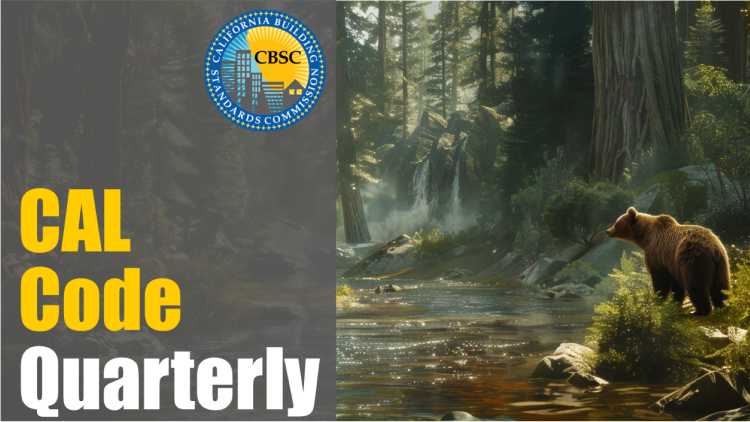
 Stoyan Bumbalov
Stoyan Bumbalov
Welcome to the 2025 autumn edition of CALCode Quarterly. We hope you like our new masthead featuring Codie the Bear! As we enter this new season and look forward to the holidays, California Building Standards Commission (CBSC) team members are busy managing commission activities, preparing for the 2025 Intervening Code Adoption Cycle, and navigating changes in the laws that govern what we do and how we do it, such as Assembly Budget Trailer Bill 130 (Chapter 22, Statutes of 2025) (AB 130).
CBSC is a state program that values transparency, and in this edition, we will do our best to share with you the current landscape for developing and amending statewide building standards that are published in the California Building Standards Code, Title 24 of the California Code of Regulations (Title 24).
AB 130 enacts a six-year moratorium on state and local building standards affecting residential units and also enacts permanent restrictions on the type of Title 24 proposals a state agency may promulgate during an intervening code adoption cycle. The sections of AB 130 that affect CBSC’s activities are 29 – 31 and 37 – 42.
The bill was signed into law on June 30 and went into effect on October 1. While CBSC is still working with its legal and legislative partners to fully and correctly interpret and apply the new law, we know that state agency representatives, local government building officials, and others have a lot of questions.
We worked closely with our legal team to ensure that communications with local building officials regarding the impact of the law were accurate, to the best of our ability. On September 22, we issued Information Bulletin 25-03 to provide uniform guidance as of that date regarding local amendments to Title 24. CBSC is also working to develop uniform guidance for the proposing and adopting state agencies affected by AB 130. We want to complete this task by the end of the month.
At the commission meeting on October 15, CBSC honored and said goodbye to longtime commissioner Erick Mikiten. Commissioner Mikiten has served as CBSC’s public member representing the disability community since 2012, and his experience and insights have been extremely valuable to other commissioners and staff alike. Please see the separate featured article below.
Also in this newsletter, we celebrate the retirement of Staff Services Manager I Cynthia Biederman, and welcome two new staff members – Kristina Severon and Les Young. Learn more about each of them in our featured articles below.
Check out the Education and Outreach sidebar to learn about our visits with building officials and design professionals during the last few months. If you’re interested in having a CBSC representative speak at a meeting or event, please let us know.
Finally, Codie the Bear will share information about the newly updated Guide to the California Green Building Standards Code - Nonresidential (CALGreen Guide). Be sure to visit Codie’s Den below.
Our next newsletter will be after the first of the year, so today I will wish you “Happy holidays and a successful new year!”
Feature Articles Fall 2025
The 2025 Intervening Code Adoption Cycle began earlier this year with several workshops hosted by the California Building Standards Commission and other state agencies with authority to develop building standards for the California Building Standards Code, Title 24 of the California Code of Regulations (Title 24). The meetings hosted by CBSC were:
March 20 – CALGreen Carbon Reduction Collaborative (CCRC) #1
July 2 – CALGreen Electric Vehicle Workgroup (CEVW) #1
July 10 – CCRC #2
July 16 – Plumbing Code Workshop
September 4 – CEVW #2
September 10 – CCRC #3
September 25 – SB 745 – Nonresidential #1 (Drought-Resistant Buildings Act)
Workshops are an opportunity for industry experts and interested parties to provide input on the code development process. Note that the precycle workshops for SB 745 – Nonresidential are the first steps in development of regulations to be proposed during the 2027 Triennial Code Adoption Cycle. Activities are starting now to allow time for a CEQA evaluation prior to the deadline to submit proposals for the 2027 cycle. If you’re interested in learning what happened at these workshops, they were livestreamed on YouTube and the recordings can be viewed now on CBSC’s YouTube channel.
Other state agencies that contribute to Title 24 are also conducting separate workshops specific to their authorities. All rulemaking packages are due to be submitted to CBSC no later than December 1, 2025.
Additionally, CBSC is navigating changes in the law that affect our day-to-day operations, such as Assembly Budget Trailer Bill 130 (Chapter 22, Statutes of 2025) (AB 130). See CBSC Information Bulletin 25-03 for more information.
Coordination of dates for virtual Code Advisory Committee meetings is in progress. Based on information provided by state proposing and adopting agencies regarding the number and complexity of submittals, there will be two ad hoc committees: Green Building and Plumbing, Mechanical, Energy (GREEN/PEME), and Building, Fire, Other and Structural Design/Lateral Forces (BFO/SDLF). The Accessibility (ACCESS) and Health Facilities (HF) Code Advisory Committee meetings will be held separately.
The tentative proposed dates are:
HF – January 28, 2026
GREEN/PEME – February 11-12, 2026
BFO/SDLF – February 18-19, 2026
ACCESS – March 4-5, 2026
The California Building Standards Commission (CBSC) announced the retirement of Commissioner Erick Mikiten at its October 15 meeting. His term expires at the end of this year. The commission owes a great deal of its success to Mr. Mikiten, and CBSC would like to acknowledge our collective gratitude for his efforts.
Commissioner Mikiten is a wheelchair-riding architect who also uses hearing aids. As principal architect of Mikiten Architecture, Mr. Mikiten has unique expertise in accessibility and universal design. He has designed hundreds of dwelling units as part of affordable and market-rate housing throughout the Bay Area, many for people with physical and/or cognitive disabilities. He has also conceived dozens of single-family home remodels for people with wide-ranging abilities, which require unique and creative approaches to result in real usability. Mr. Mikiten has been featured in numerous magazine articles about his work and design concepts.
Additionally, Mr. Mikiten has helped large corporations define wide-ranging strategies for inclusion, from their physical environment to hiring practices to workplace apps that increase participation for all employees, and he has served as an expert witness testifying on accessibility issues.
Mr. Mikiten has published two tour books for wheelchair riders that cover accessible beaches and waterfronts in the San Francisco Bay Area and Los Angeles. He has also consulted for the California Coastal Conservancy on a number of access improvement projects, and created a new beach design for Gleason’s Beach north of San Francisco. In 2025, he was elevated to the College of Fellows at the American Institute of Architects—a rare achievement!
With all of that expertise and experience, Commissioner Mikiten has been a valuable member of CBSC for 14 years, providing insights into how Title 24 is used and interpreted by designers, as well as how codes impact wheelchair riders and other persons with disabilities.
At the October 15 meeting, Executive Director Stoyan Bumbalov graciously thanked Erick for his service to the commission and the state of California, and presented him with a certificate of appreciation.
Commissioner Mikiten spoke briefly about his service, stating that he didn’t expect to serve this long, but felt he was making a difference and enjoyed working with everyone. He plans to shift his efforts to raise awareness of voluntary measures that can be taken in planning and design to make the world more livable for persons with disabilities, and will pursue efforts with the Living Future Institute, among other activities.
As the commission meeting drew to a close, Commissioner Kent Sasaki spoke in recognition of Commissioner Mikiten’s “detailed, diligent reviewing [of] proposals,…[and] asking in-depth questions” when there have been issues on access proposals. Sasaki concluded saying, “It’s been a pleasure and an honor to work with Commissioner Mikiten and all of us commissioners will greatly miss him and his contributions.” Commissioner Mikiten then made his final motion to adjourn his final meeting with CBSC. You can watch the October 15 commission meeting on CBSC’s YouTube channel.
Please join us in wishing Erick the best in his future endeavors to promote and design affordable, equitable and accessible buildings for all.
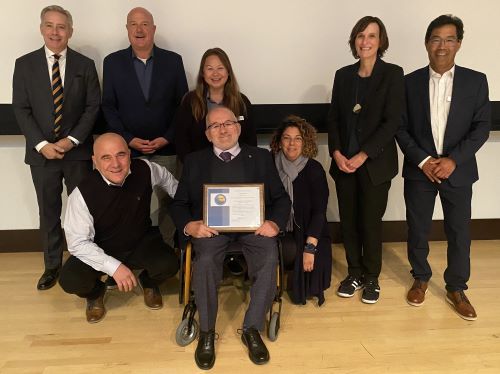
Back row: Chair Nick Maduros and Commissioners Stockwell, Alegre, Rambin and Sasaki
Front row: Executive Director Stoyan Bumbalov and Commissioners Mikiten and Klausbruckner
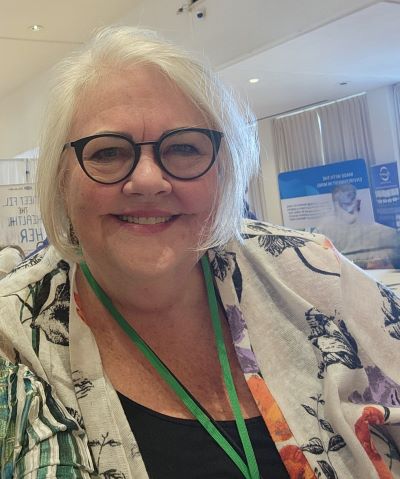
One look at Cynthia’s CBSC biography, and you can tell she’s not your everyday state employee. For starters, she is a two-time CBSC employee, who worked here from 2009 to 2017, and then came back in 2023! For another, she’s been all over North America and lived in the UK. She has a background in the music industry, where she met with stars such as the rock band Iron Maiden, and has a degree in professional services/organizational leadership.
You recognize that there’s something special about Cynthia when you meet or work with her, because she has a warm personality that shines in every interaction. As our office manager, she’s kept things running smoothly and, even when it’s challenging, there’s always something fun to brighten our days. Staff Services Manager I (Specialist) Lara Paskins says, “I wish I had worked with Cynthia for longer… but since my start with CBSC, Cynthia has been my ‘safe space.’ She is so approachable and always open to taking a few minutes out of her day to check in with me. I truly appreciate her sincere concern and interest in my life… and her ability to make me laugh!”
One of Cynthia’s biggest accomplishments during the past two years was the CBSC office remodel, which included new (to us) workstations, and the acquisition, design, development and—coming soon—occupancy of a new, high-tech conference room. This was done at a lowered expense to the state, because Cynthia salvaged the workstations, conference room chairs, and other furniture from another state agency that was moving and leaving them behind! As an avid “thrifter” and garage sale treasure hunter, this was the ultimate find for her. And as a dedicated state employee, it was gratifying to be able to refresh the office at a much-reduced cost. The project did not come without its challenges, and thinking about that, Executive Director Stoyan Bumbalov says, “When working on projects, Cynthia is like a stone. She sits on the project ground and doesn’t move or let go until the project is successfully completed. I don’t recommend anybody to try moving her from there when she is concentrated.”
As Cynthia heads out the office door for the last time, CALCode Quarterly asked her to reminisce just a little bit…
CALCode Quarterly: What are a couple of your best CBSC memories?
Cynthia: I joined the CBSC team in 2009, when California’s green building codes were in their infancy. The governor had directed then-Executive Director Dave Walls to develop green building codes for the state. The result was the addition of three new CBSC staff, including me, and the first-in-the-nation, if not world, green building standards code. Initially, the codes were voluntary, but it didn’t take long before the first mandatory codes were added to Title 24. Commission staff were charged with training stakeholders throughout the state on the new codes. One of my primary responsibilities was to coordinate [those] education and outreach training sessions. It was exciting to be part of such monumental change. Another memorable thing about CBSC has always been the teamwork. CBSC has had little turnover during the years I have been [here]. It's been a privilege to work on something day in and day out that impacts virtually every Californian (whether they know it or not!).
You’ve traveled a lot during your career. What was one of your favorite places to live or visit? Will you go back there after retirement?
I’m so thankful for all those wonderful experiences. Among those travels, I had the opportunity to work in Florida a lot and absolutely loved the Miami South Beach area and the Florida Keys. The weather, the ocean and the vibe were always so inviting. I would return at the drop of a hat!
What are you looking forward to in retirement?
Free time to work on my home projects and to pursue interests that I haven’t made time for. I’ve worked nonstop since I graduated from high school—including my college years. My career has always been front and center, and all-consuming. I’m looking forward to participating in more social activities, going to the gym on a regular basis, working with an animal rescue, reading more, and yes, traveling! I also hope to expand my creative interests.
Anything else you’d like to share?
It’s been an honor to wrap up my state career at CBSC. Such good people with a genuine sense of purpose in everything they do. I will miss everyone.
CBSC Colleagues Share Their Memories
As we say farewell to Cynthia, CBSC team members shared thoughts about their time working with her:
Associate Architect Havel Weidner: Cynthia is incredibly kind and caring. Having been recently hired, I remember her being reassuring and welcoming throughout the interviewing and onboarding process, and as I’ve come to know her better it’s clear that this is genuinely a part of who she is – someone that wants the best for those around her, even the ones she’s just met.
Associate Architect Tim Freeman: [Cynthia is] thoughtful in her role and a valued part of our staff. I’ll certainly miss her good-humored personality as well as the kindness and joyfulness that has shone through every day.
Associate Construction Analyst Tom Martin: It has been great working with Cynthia! She is constantly doing anything and everything she can to make everyone’s work life better.
Associate Governmental Program Analyst (AGPA) Kristina Severon (Webmaster and Legislative Analyst): Cynthia's kindness and calm presence has made such a lasting impression. From the moment I started my new role here at CBSC, she was the picture of patience and compassion. [She said to me,] "You're going to fit right in. This is a place where we celebrate each other’s growth and support one another every step of the way." She will be greatly missed, and I wish her nothing but the best in her next great adventure.
AGPA Laura Mills (Education and Outreach): I am just stunned by Cynthia’s coolness! She has traveled places and met people and participated in momentous events throughout her career. She has the BEST stories! She is also a really good boss, who knows how to give praise and to constructively correct with kindness. I am going to miss Cynthia and I wish her more awesome adventures in retirement.
Deputy Executive Director Kevin Day: I have been very fortunate to have worked with Cynthia since I first started with CBSC back in 2010 – she and I were cubicle neighbors and immediately found common ground in the arts and culture. Her thoughtfulness, passion, and professionalism are unmatched. I was thrilled when Cynthia returned to CBSC in 2023 and she has worked tirelessly to ensure the success of our program. Her dedication to the people of California is immeasurable and while I will miss her terribly, I wish her all the best in her well-earned retirement.
AGPA Barbara Trusley (Personnel and Finance): Cynthia has been wonderful to work with over the last couple of years. She’s been a great leader and team player, and has done a tremendous job handling CBSC’s recent large projects. Cynthia is fabulous and fun, and we’ll miss her when she retires (though we still expect her to visit now and then).
Architectural Associate Timothy O’Malley: I will miss Cynthia's hearty laugh, and her light and subtle wit.
Kristina Severon joined CBSC in September 2025. With a varied background of state service and private-industry experience, she joins our staff as lead web content author and legislative analyst. Let’s get to know Kristina a little bit better…
CALCode Quarterly: What inspired you to apply for this position at CBSC? What are you looking forward to working on?
Kristina: I was inspired to work at the California Building Standards Commission because it gave me the opportunity to build on my interest in managing and creating content for public-facing websites while also learning about the legislative process. I’m motivated by the opportunity to learn how building standards are developed, reviewed, and implemented, and how legislation guides that work. Being part of CBSC gives me a chance to not only support this process but also grow my knowledge of government operations and public policy.
CALCode Quarterly was intrigued by your biography, and we have a question: What are “vehicle graphics”?
Vehicle graphics are custom-designed images, decal lettering, or wraps applied to cars, trucks, boats, trailers or other vehicles to convey a message. Made from durable, weather-resistant vinyl, vehicle graphics are designed to last for years yet they can also be removed without damaging the paint. This flexibility allows businesses to display logos, contact information, and promotional designs that reach thousands of viewers daily.
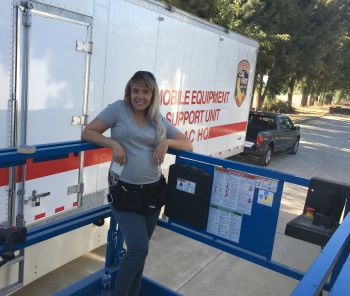
Kristina with one of her "big" vehicle graphic jobs!
Please tell us more about your interest in native California plants. There are so many climates and vegetation regions in California. Do you have a favorite region/plant?
I am particularly drawn to the Great Central Valley, Central Western California, and Sierra Nevada regions, which I frequently visit to explore and self-study the native flora firsthand. I am fascinated by the succulents such as the Canyon Live-Forever Dudleya, the Mariposa lilies, and the Woodland Pinedrops. I enjoy discovering new species on each excursion, no matter what the weather.
Do you want to share anything else with our readers?
During my twenties, I took multiple solo backpacking trips through Europe, which deepened my curiosity about the world. Since then, I have been motivated to pursue new challenges, including earning my ham radio and pilot licenses.
Welcome, Kristina! We are looking forward to working with you!
CBSC’s newest team member is Les Young, who joins us as an Associate Architect.
When asked what prompted him to apply for this position, Les stated that he learned about CBSC during recruitment efforts for the executive director position. After discovering more about CBSC’s mission, vision and program responsibilities, he became interested in state service, particularly working on the development of building standards.
This Associate Architect position will allow Les to share his many years of experience with the team. He says, “I am especially interested in sustainability and alternative energy and how building standards can assist communities [to] achieve their goals with those efforts.”
Some of the projects Les worked on in Cincinnati and San Francisco include:
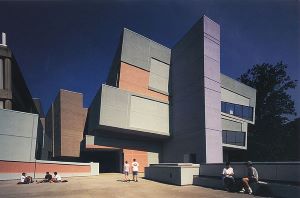
The Aranoff Center for Design and Art, Cincinnati (one of four original designers)

The KPMG Building, San Francisco (project architect)
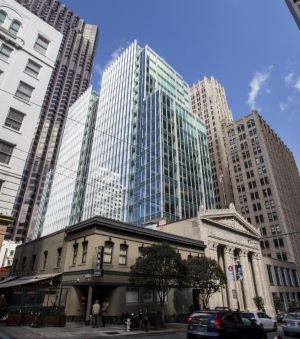
The Gemdale USA Building, San Francisco (project architect)
Please join us in welcoming Les to CBSC.
Codie's Den Fall 2025

Hello friends, I hope that you are having a grrrr-eat fall season so far. As the leaves of the deciduous trees in the forest are turning from greens to golds and reds, I’m here to share the news about CBSC’s 2025 Guide to the California Green Building Standards Code – Nonresidential, also known as the CALGreen Guide. (Oh look, there’s me on the inside cover page!)

CBSC’s authority is for non-residential green building standards, so this guide focuses on Chapters 5 and A5 in the California Green Building Standards Code (CALGreen, Part 11 of Title 24). Note that the California Department of Housing and Community Development makes its own guide for residential CALGreen codes. The CALGreen Guide is published every three years to accompany the triennial edition of Part 11 and is available from the International Code Council in a paperback form. Watch the CALGreen webpage to see when the link is posted.
Back in 2010, when the mandatory CALGreen code was still new, CBSC realized that code users might need some assistance with interpreting, applying and enforcing the unfamiliar sustainable building standards, so it was decided to design and publish a guidebook with more information such as what the code is intended to accomplish, and how a building department might review for compliance.
As the code has evolved, so has the guide, and it is now an essential accessory to CALGreen. Let’s take a closer look at how the guide is set up to assist code users and enforcement officials.
First, the guide mirrors Part 11 chapters and sections, showing code text in green lettering by section. Next, for each section, there is an explanation of the intent of the requirement, sometimes including a reference to laws or other regulations that may have served as a catalyst for the code.
If there were any changes during the most recent two code adoption cycles (an intervening and triennial), those are then identified and explained, as necessary.
For designers and builders, compliance methods are suggested and examples provided to show what might be included in construction drawings and specifications to show compliance with CALGreen requirements.
Finally, recommendations are provided for enforcement officials to use at plan review and during on-site inspections to ensure code compliance.
Additionally, for some of the more complicated requirements, such as the embodied carbon reduction regulations, CBSC has provided use-case scenarios to help users understand how to apply the code.
The CALGreen code’s checklists and worksheets are also reproduced in the CALGreen Guide, for ease of reference and use by designers and builders.
All of this serves to provide a comprehensive companion to CALGreen that helps California remain on track to meet its sustainability goals.
If you’re a CALGreen user, I hope you’ve found this review of the CALGreen Guide enlightening. Of course, if you ever have any questions, my friends at the CBSC office are there to help you, so give them a call at (916) 263-0916 or email cbsc@dgs.ca.gov.
And now, for a little bit of fun, test your CALGreen Guide knowledge by taking the quiz!

Well, it’s getting close to torpor time again…I think I’ll go look for some grrrrr-ubs and grrrr-eens. So long until next time!

New CBSC Chairperson
The October 15 commission meeting was led by new CBSC Chairperson Nick Maduros, who is the secretary of the Government Operations Agency (GovOps) appointed in March 2025. Mr. Maduros was previously director of the California Department of Tax and Fee Administration and prior to that was chief of staff of the U.S. Small Business Administration under president Barack Obama. Learn more about Mr. Maduros by reading his GovOps biography. CBSC is pleased to welcome and work with our new chairperson.

Nick Maduros
Education and Outreach
August 13 and September 19 – ICC Peninsula Chapter – Local adoption & amendment of Title 24
Every three years, when a new edition of Title 24 is published, local jurisdictions in the state have the option to amend building standards based on local climatic, topographical or geological conditions (and environmental conditions in the case of amendments to CALGreen, Part 11 of Title 24). For the local amendments—also known as ordinances—to be accepted for filing and enforceable at the local level, specific requirements must be met. On August 13, Associate Construction Analysts Beth Maynard and Tom Martin attended an International Code Council (ICC) Peninsula Chapter workshop in Santa Cruz to share how cities and counties can successfully submit their ordinances to CBSC. For the second session on September 19, Deputy Executive Director Kevin Day and Associate Construction Analyst Enrique Rodriguez visited with another group of building officials in Milpitas. CBSC is pleased to be able to meet with and help local building officials successfully meet the requirements of law when filing amendments to Title 24.
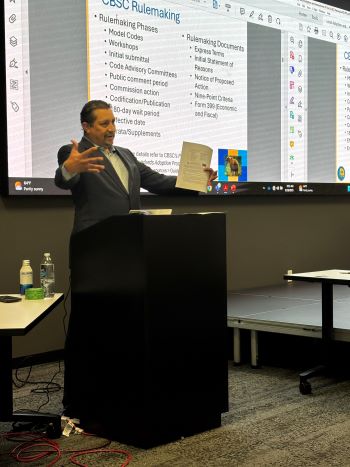
Enrique shares the CBSC rulemaking process.
August 14 – SVABO Field Trip – Simpson Strong Tie (seismic parts)
Staff Services Manager I (Specialist) Carol Hagler, Associate Architect Tim Freeman, and Associate Construction Analyst Tom Martin joined the Sacramento Valley Association of Building Officials (SVABO) for a field trip to the Simpson Strong Tie factory in Stockton. They were able to tour the facility where Simpson makes and tests their wood construction connectors using an earthquake simulator. When asked about the experience, Tom said, “It is amazing that the floor [of the testing lab] is three-feet-thick concrete...This was done because original testing was creating ‘seismic events’ in the local area.” CBSC thanks SVABO for the opportunity to participate in the fascinating tour and hang out with some awesome building officials.
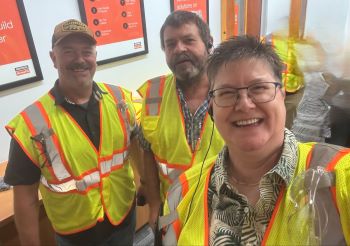
Tim, Tom and Carol on the Simpson Strong Tie tour.
August 19 – ICC San Diego – Local adoption and amendment of Title 24
Deputy Executive Director Kevin Day joined ICC’s San Diego Chapter monthly meeting to share information about local adoption and amendment of the new 2025 Title 24. Kevin joined the chapter members via Zoom, spoke for about 30 minutes and then answered questions and provided clarification about CBSC’s work to interpret and provide guidance on new statutes affecting building standards development. (See the “Executive Director Message” and “Cycle Status” articles for more about the new law.)
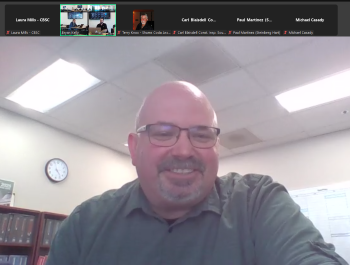
Kevin shares CBSC information with San Diego ICC members.
September 9 – CBSC’s Rulemaking Training
At the start of every code adoption cycle, CBSC offers rulemaking training to state agency representatives who will be participating in the cycle. This year’s training in advance of the 2025 Intervening Code Adoption Cycle was held virtually and attended by approximately 50 representatives of 11 state agencies. The session covered vital information about the cycle, including the correct templates to use, the process for document submittals, and due dates. Participants were able to ask questions in advance, and there was a Q&A at the end of the presentation to ensure that everyone received the same information.
September 18 – LMS Architects
The code users at Leddy Maytum Stacy Architects of San Francisco invited Associate Construction Analyst Enrique Rodriguez to join them for a “brown bag” session and share information about the California Green Building Standards Code (CALGreen), Part 11 of Title 24. During their lunch hour, Enrique provided a bit of history about CALGreen and CBSC, as well as new electric vehicle charging updates and plans for future amendments to the nonresidential regulations under the authority of the Building Standards Commission.
October 16 – Great Shakeout Earthquake Drill
Each year, CBSC team members join in the Great Shakeout earthquake awareness drill. On October 16, Deputy Executive Director Kevin Day and Associate Construction Analyst Tom Martin took part by following the Great Shakeout prompts to “Drop, Cover, and Hold On” at their workstations in CBSC’s office.
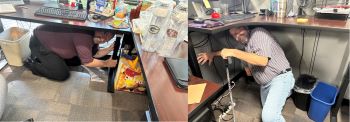
Kevin and Tom drop, cover and hold on!
Upcoming Events
November 4 – CBOAC Annual Conference and Business Meeting Executive Director Stoyan Bumbalov will visit the County Building Officials Association of California (CBOAC) at their Annual Conference and Business Meeting in Morro Bay to present information about CBSC activities and plans for the upcoming code adoption cycle. If you’re a county building official, he’ll see you there!
November 5 – Greenbuild International Conference and Expo Supervising Architect Irina Brauzman will join representatives from the California Division of the State Architect at the Greenbuild conference in Los Angeles to speak about California’s efforts to promote green (sustainable) building in the state. If you attend the session, please stop by and introduce yourself.
